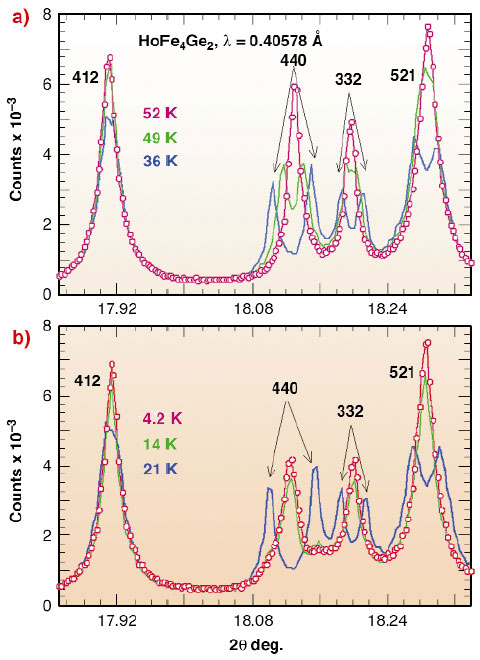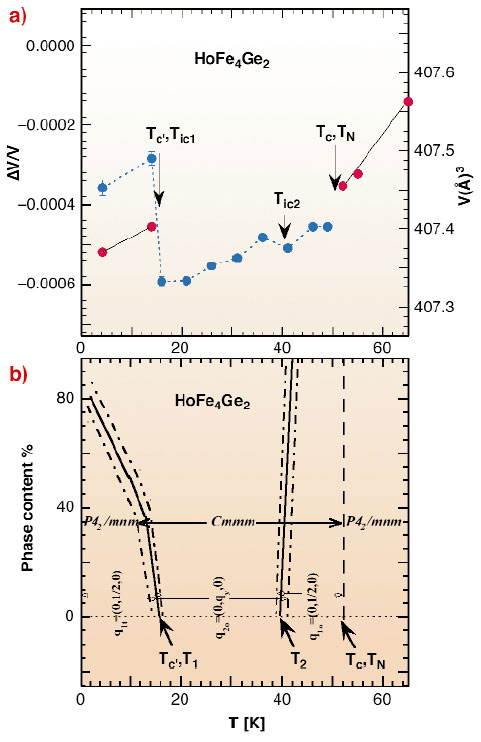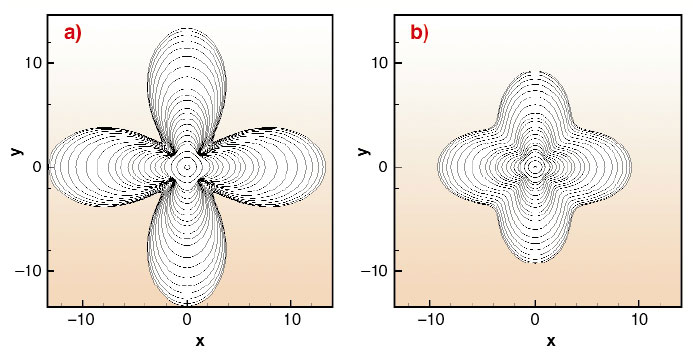- Home
- Users & Science
- Scientific Documentation
- ESRF Highlights
- ESRF Highlights 2003
- Materials Science
- Re-entrant Magneto-elastic Phase Transition in HoFe4Ge2
Re-entrant Magneto-elastic Phase Transition in HoFe4Ge2
The compound HoFe4Ge2 undergoes on cooling a sequence of re-entrant magneto-elastic phase transitions from a tetragonal high symmetry, high temperature (HT) P42/mnm phase, to an orthorhombic low symmetry, intermediate temperature (IT) Cmmm phase, then to a tetragonal high symmetry, low temperature (LT) P42/mnm phase (Figures 41 and 42) following the path P42/mnm HT (Tc,TN = 52 K) ![]() Cmmm IT (Tc',Tic1 = 15 K)
Cmmm IT (Tc',Tic1 = 15 K) ![]() P42/mnm LT.
P42/mnm LT.
 |
|
Fig. 41: Detail of the XRPD patterns for various temperatures displaying the pronounced peak splitting (a) below the Tc,TN, and closing (b) below Tc',Tic1 of the tetragonal hhlt |
 |
|
Fig. 42: (a) Thermal variation of the volume, referring to the C-cell. All observed transitions are accompanied by volume anomalies. The first order LT transition is related with volume expansion. (b) The structural and magnetic phase diagram of HoFe4Ge2. Full and dashed lines are first and second order transitions respectively. Dash dotted lines denote the upper and lower limit of coexistence regions around first order transitions of the adjacent magnetic and/or crystal structures. |
The analysis of high-resolution powder X-ray diffraction patterns collected at BM16 for temperatures in the range 1.5 K 293 K has shown that: a) the HT and LT transitions are of second- and first- order respectively, b) the HT and LT tetragonal phases are identical, differing exclusively in the nature of the micro-strain, see Figure 43, and c) enabled us to establish a straightforward relationship between the structural transitions and the underlying magnetic order and to demonstrate their interdependence in a phase diagram, Figure 42.
 |
|
Fig. 43: Refined anisotropic strain distribution (a) in the HT tetragonal phase at 52 K (paramagnetic state) and (b) in the LT tetragonal phase at 4.2 K. |
The phase diagram comprises three temperature intervals pertaining to distinct structures and two transitions between them occurring simultaneously with magnetic transitions: 293 K > T > Tc,TN: HT tetragonal; Tc,TN > T> Tc',Tic1 = 15 K: IT orthorhombic- and Tc',Tic1 > T > 1.5 K: LT tetragonal phases. Below the first order transition at Tc',Tic1 the latter two phases coexist in strongly variable proportions down to 1.5 K. The LT tetragonal phase reaches 73.6% at 4.2 K (Figure 41b). The magnetic ordering is characterised by the wave vectors q1o = (0,1/2,0) q2o = (0,qy,0) for the orthorhombic- and q1t = (0,1/2,0) for the tetragonal LT phase. The vector components refer to the reciprocal lattice of the C-cell. The magnetic ordering comprises an additional first-order transition at Tic2 = 40 K from the commensurate q1o phase to the incommensurate q2o phase. Also this transition is related with anomalies in the lattice parameters and volume observed in the X-ray data (Figure 42a).
All transitions are accompanied by strong micro-strain effects leading to a noticeable (hkl) dependence of the line broadening. The anisotropic peak broadening was refined using the instrumental resolution and modeling the anisotropic strain at each given temperature. The strain anisotropy of the tetragonal LT phase at 4.2 K was found to be much smaller, Figure 43. Apparently the lock-in magnetic transition at 15 K is related with an area dilatation and a contraction of the c-axis that restores the tetragonal symmetry and a volume increase. Most likely this sequence of transitions is related to competing magneto-elastic mechanisms involving the Ho crystal field anisotropy, the HoHo, HoFe and the FeFe exchange interactions and their coupling with the lattice strains. The shear strain accompanying the P42/mnm![]() Cmmm transition was attributed to the magneto-elastic coupling between the HoHo dominant interaction and the lattice strains [1]. The observed ao / bo
Cmmm transition was attributed to the magneto-elastic coupling between the HoHo dominant interaction and the lattice strains [1]. The observed ao / bo ![]() 1 deformation (referring to the
1 deformation (referring to the ![]() 2at,
2at, ![]() 2at, ct C-cell) is due to the fact that the HoHo exchange interaction is negative along bo and positive along ao. Furthermore our system comprises two competing mechanisms of geometrical frustration, one arising from the Fe compact tetrahedral arrangement with antiferromagnetic interactions, and the second from the zero molecular field created at the Ho sites by the four surrounding Fe atoms located at the corners of an oblong square and the Ho at the center with antiferromagnetic FeHo interactions.
2at, ct C-cell) is due to the fact that the HoHo exchange interaction is negative along bo and positive along ao. Furthermore our system comprises two competing mechanisms of geometrical frustration, one arising from the Fe compact tetrahedral arrangement with antiferromagnetic interactions, and the second from the zero molecular field created at the Ho sites by the four surrounding Fe atoms located at the corners of an oblong square and the Ho at the center with antiferromagnetic FeHo interactions.
Reference
[1] P. Schobinger-Papamantellos, J. Rodríguez-Carvajal, G. Andre, C. Ritter and K.H.J. Buschow. Submitted to J. Magn. Magn. Mat.
Principal Publications and Authors
P. Schobinger-Papamantellos (a), J. Rodríguez-Carvajal (b), K.H.J. Buschow (c), E. Dooryhee (d), A.N. Fitch (d). J. Magn. Magn. 250, 225 (2002).
(a) ETHZ Zürich (Switzerland)
(b) Lab.Leon Brillouin, (CEA - CNRS) Saclay (France)
(c) University of Amsterdam (The Netherlands)
(d) ESRF



